
Chapter 14: Darwin and Evolution
14.1 Darwin’s Theory of Evolution
Charles Darwin was 22 years old when he became a naturalist on the HMS Beagle in 1831.
He had a background in nature and was a collector of insects.
He was interested in science and attended lectures in biology and geology.
Darwin did geology fieldwork at Cambridge before being recommended to the captain of the Beagle as the ship's naturalist.
The voyage was supposed to take 2 years but took 5.
Darwin collected and observed a variety of lifeforms, many of which were different from those in England.
Initially, Darwin believed in the idea that species remained unchanged since creation.
During the voyage, his observations challenged this belief and led him to propose the theory of evolution.
Evolution proposes that species arise, change, and become extinct due to natural forces.
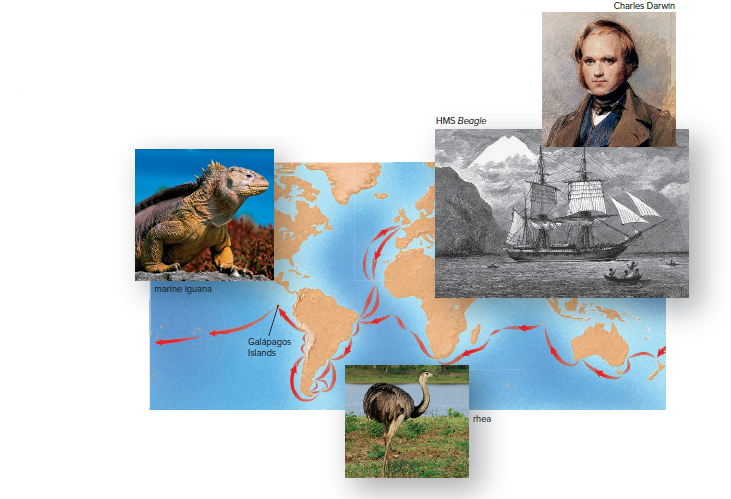
Before Darwin
Prior to Darwin, people believed that the Earth was only a few thousand years old and that species had remained the same since creation.
Investigators studied the anatomy of organisms and classified them to show that species were created to be suitable to their environment.
Explorers and collectors traveled the world and brought back currently existing species and fossils to be classified.
Fossils are the remains of once-living species found in strata, which are layers of rock formed from sedimentary material.
The ages of the strata allow scientists to estimate when these species lived, and their characteristics indicate the environment that was found in the region during that time.
Georges Cuvier founded the science of paleontology, the study of fossils, and believed in the fixity of species.
Cuvier hypothesized that a local catastrophe had caused a mass extinction whenever a new stratum of that region showed a new mix of fossils.
Cuvier's followers, called catastrophists, suggested that worldwide catastrophes had occurred and that new sets of species had been created after each event.
Cuvier and Lamarck had different views on evolution and adaptation.
Lamarck believed that evolution occurs and adaptation to the environment is the cause of diversity.
Lamarck concluded that more complex organisms are descended from less complex organisms after studying the succession of life forms in strata.
Lamarck proposed the idea of inheritance of acquired characteristics to explain the process of adaptation to the environment.
Lamarck's example of the long neck of giraffes developing over time due to stretching their necks to reach food and passing on the trait to their offspring is famous but not the primary mechanism that drives the change in species over time.
Darwin's ideas were similar to Lamarck's in that living organisms share characteristics because they have a common ancestry.
Darwin believed that species are suited to the environment through natural selection, not by their own will.
Darwin saw natural selection as the means by which different species came about.
Darwin’s Conclusions
Darwin's conclusions:
Organisms are related through common descent
Adaptation to various environments results in diversity
Based on several types of data:
Study of geology
Study of fossils
Study of biogeography
Biogeography: Study of the distribution of life forms on Earth.
Darwin’s Study of Geology and Fossils
Darwin took Charles Lyell’s book Principles of Geology with him on the Beagle voyage.
The book gave evidence that Earth is subject to slow but continuous cycles of erosion and uplift.
Weathering causes erosion; thereafter, dirt and rock debris are washed into the rivers and transported to oceans.
When these loose sediments are deposited, strata result.
The strata often contain fossils and are uplifted over long periods of time from below sea level to form land.
Lyell proposed the theory of uniformitarianism, which stated that slow changes occurred at a uniform rate.
Modern geology substantiates a hypothesis of slow and continual geological change.
Darwin observed massive geological changes firsthand during his trip.
He saw raised beaches for great distances along the coast of Argentina.
In Chile, he witnessed the effects of an earthquake that caused the land to rise several feet and left marine shells inland, well above sea level.
Darwin found marine shells high in the cliffs of the Andes Mountains.
Darwin collected fossil specimens that differed somewhat from modern species.
Once Darwin accepted the supposition that Earth must be very old, he began to think that there would have been enough time for descent with modification to occur.
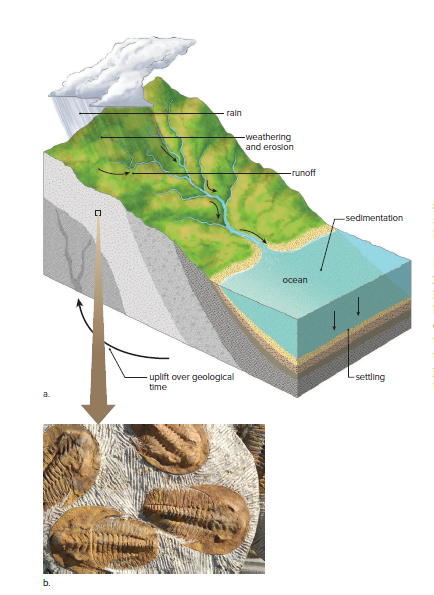
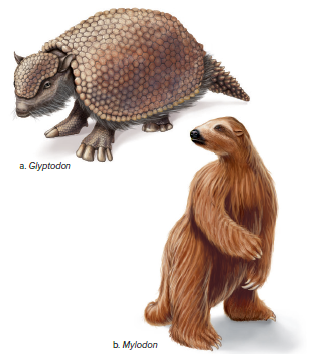
Darwin’s Study of Biogeography
Darwin compared animals in South America to those in England.
Instead of rabbits, he found Patagonian hares in South America.
The Patagonian hare is actually a rodent called Patagonian mara.
Darwin wondered if similarities were due to common ancestors or convergent evolution.
Convergent evolution is when distantly related species have similar body forms due to similar habitats and behaviors.
Darwin saw how similar species replaced one another as he sailed southward along South America's eastern coast.
Related species can be modified according to environmental differences caused by changes in latitude.
Darwin found evidence of this on the Galápagos Islands.
The Galápagos Islands have unique environments and different species from the mainland and from island to island.
Darwin wondered where the species on the islands came from and what caused the islands to have different species.
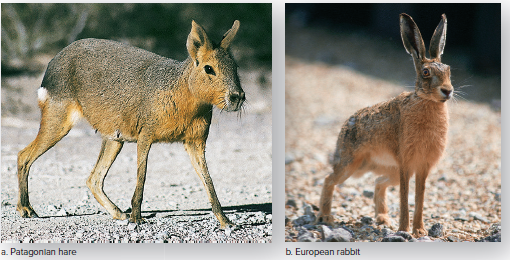
There are different types of finches on the Galápagos Islands with varying beak sizes and shapes depending on their diet and habitat.
Ground-dwelling finches have beak sizes dependent on the sizes of the seeds they eat.
Tree-dwelling finches have beak sizes and shapes depending on the sizes of their insect prey.
A cactus-eating finch possesses a more pointed beak, enabling access to nectar within cactus flowers.
The Galápagos woodpecker-type finch has a sharp beak but lacks the long tongue of a woodpecker. It carries a twig or cactus spine in its beak to poke into crevices and seize insects.
Darwin speculated whether all the different species of finches he had seen could have descended from a mainland finch or if they had evolved independently on the islands.
Each of the Galápagos Islands has its own type of tortoise, with long-necked tortoises inhabiting dry areas and short-necked tortoises found in moist regions with abundant ground foliage.
Darwin wondered if the differences in tortoise types could be correlated with differences in vegetation on the islands and if they had evolved from an ancestral tortoise from the mainland of South America.

Natural Selection and Adaptation
Darwin proposed natural selection as the mechanism of evolutionary change after recognizing that adaptations develop over time.
Natural selection requires the following steps:
The members of a population have heritable variations.
The population produces more offspring than the resources of an environment can support.
The individuals that have favorable traits survive and reproduce to a greater extent than those that lack these traits.
Over time, the proportion of a favorable trait increases in the population, and the population becomes adapted to the environment.
The finches of the Galápagos Islands have continued to provide a wealth of information on evolutionary processes.
Drs. Peter and Rosemary Grant led a 30-year study of a species of ground finch on the island of Daphne Major in the Galápagos, documenting the evolutionary change of a species in response to changes in the environment.
Natural selection lacks any directedness or anticipation of future needs and is an ongoing process because the environment of living organisms is constantly changing.
Extinction can occur when previous adaptations are no longer suitable for a changed environment.
Organisms Vary in Their Traits
Darwin emphasized that population members have functional, physical, and behavioral variations.
Prior to Darwin, variations were considered imperfections and ignored.
Darwin realized that variations are essential to natural selection.
Darwin believed that variations occur randomly and for no particular purpose.
Genes and environment determine an organism's phenotype.
Inherited genes are based on chromosome assortment during meiosis and fertilization.
New alleles result from inheritable mutations in an organism's DNA.
Mutations are more likely to be harmful than beneficial.
Occasionally, a mutation produces a benefit, such as a change in camouflage.
This type of variation is passed on from generation to generation, allowing for adaptation to the environment.
Organisms Struggle to Exist
Thomas Malthus emphasized the reproductive potential of humans in Darwin's time.
Malthus proposed that death and famine are inevitable due to the human population increasing faster than the food supply.
Darwin applied this concept to all organisms and found that available resources were insufficient for all members of a population to survive.
Darwin calculated the reproductive potential of elephants and concluded that a single pair of elephants' descendants would number about 19 million after 750 years.
No environment can support an elephant population of this magnitude.
Each generation has the same reproductive potential, leading to a constant struggle for existence.
Only certain members of a population survive and reproduce each generation.
Organisms Differ in Fitness
Darwin emphasized that variations are essential to the natural selection process.
Prior to Darwin, variations were considered imperfections that should be ignored.
Darwin realized that variations are functional, physical, and behavioral characteristics.
Darwin suspected that the occurrence of variations was completely random.
Genes, together with the environment, determine the phenotype of an organism.
New alleles of a gene are the result of inheritable mutations in the DNA of the organism.
Mutations are more likely to be harmful than beneficial to an organism.
Occasionally, a mutation occurs that produces a benefit to the organism.
Fitness is the reproductive success of an individual relative to other members of the population.
Fitness is determined by comparing the number of surviving fertile offspring that are produced by each member of the population.
The fittest individuals are the ones that capture a disproportionate amount of resources and convert these resources into a larger number of viable offspring.
What determines fitness varies for different populations.
Background matching helps an animal both capture prey and avoid being captured.
Darwin noted that when humans carry out artificial selection, they breed selected animals that have particular traits they want to reproduce.
In nature, interactions with the environment determine which members of a population reproduce to a greater degree than other members.
The result of natural selection is not predesired.
Natural selection occurs because certain members of a population happen to have a variation that allows them to survive and reproduce to a greater extent than other members.
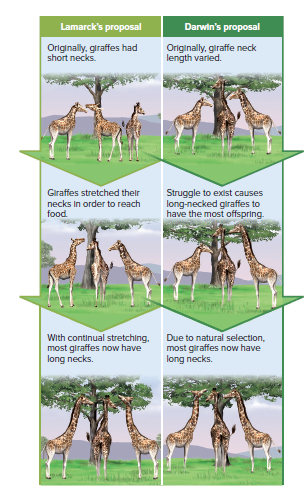
Organisms Become Adapted
Adaptations may take many generations to evolve.
Unrelated organisms living in a particular environment may display similar characteristics as an adaptation.
Manatees, penguins, and sea turtles all have flippers as an example of convergent evolution.
Adaptations help organisms escape their predators and are suited to their way of life.
Natural selection causes adaptive traits to be increasingly represented in each succeeding generation.
Natural selection is the process that allows a population to adapt to its environment.
Other processes are also at work in the evolution of populations.
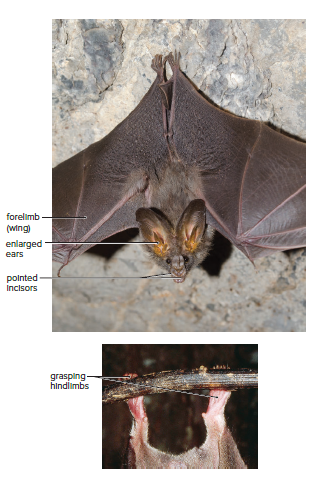
Darwin and Wallace
Darwin waited over 20 years to publish his book On the Origin of Species after the HMS Beagle returned to England in 1836.
During this time, he used the scientific process to support his hypothesis that today's diverse life forms arose by descent from a common ancestor and that natural selection is a mechanism by which species can change and new species can arise.
Darwin was prompted to publish his book after reading a similar hypothesis formulated by Alfred Russel Wallace.
Wallace was an English naturalist who went on collecting trips to the Amazon and the Malay Archipelago, where he divided the islands into a western and eastern group based on the organisms found there.
The sharp line dividing these two island groups within the archipelago is now known as Wallace's Line.
Wallace wrote an essay called "On the Law Which Has Regulated the Introduction of New Species," where he proposed that every species has come into existence coincident both in time and space, with a preexisting closely allied species.
After reading Malthus's treatise on human population increase, Wallace conceived the idea of "survival of the fittest" and proposed natural selection as an agent for evolutionary change in an essay he sent to Darwin for comment.
Darwin was stunned and found Wallace's ideas to be so similar to his own that even Wallace's terms now stand as heads of his chapters.
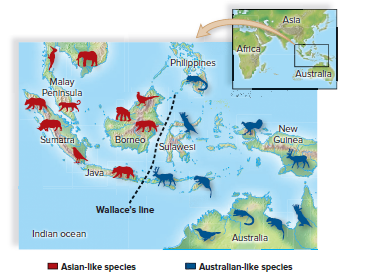
Darwin suggested that Wallace's paper be published immediately.
Lyell and others suggested that a joint paper be read to the Linnean Society.
On July 1, 1858, Darwin and Wallace presented a joint paper to the Linnean Society.
Darwin's section of the paper was titled "On the Tendency of Species to Form Varieties; and on the Perpetuation of Varieties and Species by Natural Means of Selection."
Wallace's section of the paper was titled "On the Law Which Has Regulated the Introduction of New Species."
The joint paper announced to the world that species share a common descent and have diverged through natural selection.
14.2 Evidence of Evolutionary Change
The evolutionary theory includes natural selection and descent with modification.
All living organisms have a common ancestor.
Each organism has become adapted to its environment through natural selection.
A hypothesis becomes a scientific theory when supported by evidence from independent investigators.
Darwin suggested natural selection as the mechanism for species change over 150 years ago.
Countless scientific studies have supported the ideas of species changing over time, being related through common descent, and being adapted to their environment through natural selection.
Evolution is the unifying principle in biology.
Evolutionary theory helps biologists understand the complex nature of life in various fields of biology.
This section will explore evidence of evolutionary change.
Darwin was aware of much of this evidence except for biochemical data.
Fossil Evidence
Fossils in rock strata provide the fossil record that tells us about the history of life.
The fossil record shows a succession of life-forms from simple to complex, but occasionally this pattern is reversed.
Transitional fossils are particularly interesting as they serve as links between groups.
Archaeopteryx fossils show that birds have reptilian features, including jaws with teeth and long, jointed tails.
Tiktaalik roseae is a transitional form between fish and four-legged animals, the tetrapods, estimated to be 375 million years old.
Tiktaalik has a mix of fishlike and tetrapod-like features that illustrate the steps in the evolution of tetrapods from a fishlike ancestor.
A snake fossil dated to 90 MYA showed hip bones and hindlimbs, a trait absent in all living snakes and is considered a transitional link between lizards and snakes.
The fossil record also provides important insights into the evolution of whales from land-living, hoofed ancestors.
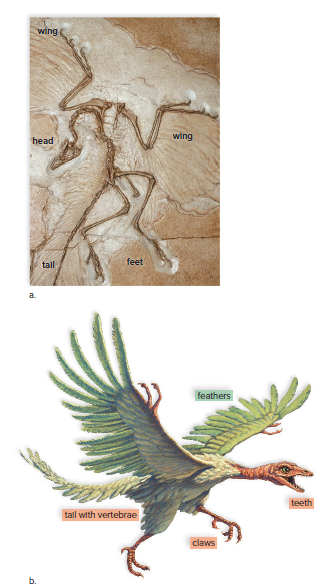
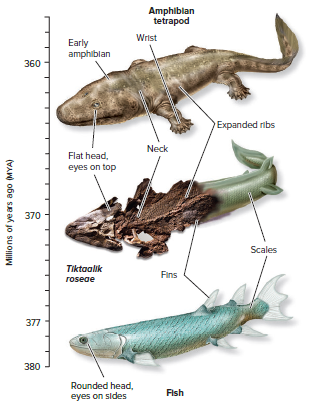
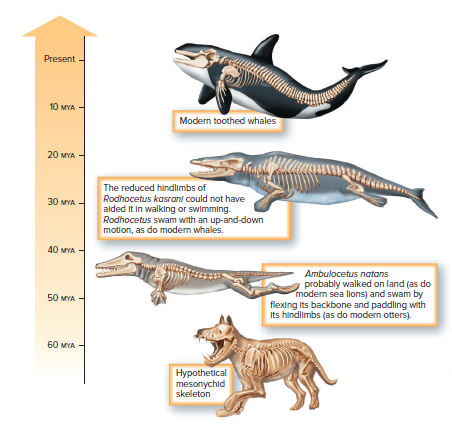
Biogeographical Evidence
Biogeography is the study of the distribution of organisms throughout the world.
Organisms evolve in one place and then spread to other accessible regions.
Different mixes of plants and animals are expected wherever geography separates continents, islands, or seas.
Darwin noted that South America lacked rabbits, even though the environment was suitable for them, concluding that rabbits evolved elsewhere and had no means of reaching South America.
Cactuses and euphorbia are plants adapted to a hot, dry environment, but they grow in different continents because they evolved similar adaptations on their respective continents.
Islands are home to many unique species of animals and plants found nowhere else, and the reasonable explanation is that an ancestral species migrated to different islands and evolved into different species due to geographic isolation.
Marsupials and placental mammals arose when South America, Antarctica, and Australia were connected, but marsupials are now plentiful only in Australia because they had no competition from placental mammals.
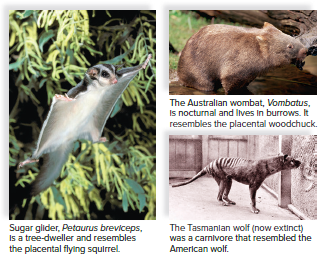
Anatomical Evidence
Darwin showed that the common descent hypothesis explains vestigial structures and anatomical similarities among organisms.
Vestigial structures are fully developed in one group of organisms but reduced and nonfunctional in other similar groups.
Examples of vestigial structures include reduced wings in ostriches, remnants of hip bones and legs in extinct whales and snakes, and tailbones in humans.
The common descent hypothesis explains the presence of vestigial structures as organisms inherit their anatomy from their ancestors.
Vertebrate forelimbs have different functions but contain the same sets of bones organized in similar ways.
The unity of anatomy in vertebrate forelimbs is explained by the basic forelimb plan belonging to a common ancestor.
Anatomically similar structures explainable by inheritance from a common ancestor are called homologous structures.
Analogous structures serve the same function but are not constructed similarly and could not have a common ancestry.
The wings of birds and insects are analogous structures.
All vertebrates have a postanal tail and exhibit paired pharyngeal pouches supported by cartilaginous bars during embryological development.
Pharyngeal pouches develop into functioning gills in fishes and amphibian larvae.
In humans, the first pair of pouches become the cavity of the middle ear and the auditory tube, the second pair becomes the tonsils, and the third and fourth pairs become the thymus and parathyroid glands.
New structures originate by modifying the preexisting structures of an organism's ancestors.
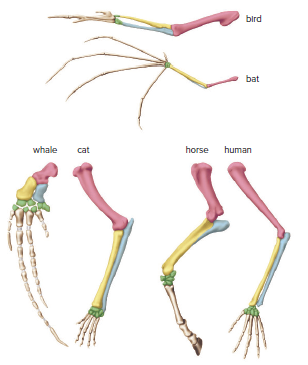
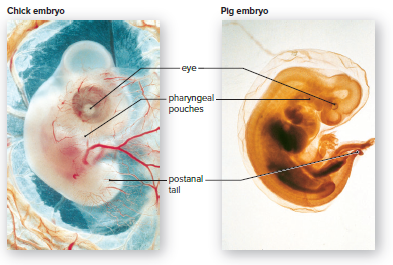
Molecular Evidence
All living organisms use the same basic biological molecules, including DNA, ATP, and many identical or nearly identical enzymes.
Organisms utilize the same DNA triplet code and the same 20 amino acids in their proteins.
Humans share a large number of genes with much simpler organisms.
Many developmental genes, called Hox genes, are shared in animals ranging from worms to humans.
Life’s vast diversity has come about through only slight differences in the same genes.
A similar gene in arthropods and vertebrates determines the back-to-front axis, but although the base sequences are similar, the genes have opposite effects.
When the degree of similarity in DNA base sequences of genes or in amino acid sequences of proteins is examined, the data are as expected, assuming common descent.
Data regarding differences in the amino acid sequence of cytochrome c show that the sequence in a human differs from that in a monkey by only 1 amino acid, from that in a duck by 11 amino acids, and from that in Candida, a yeast, by 51 amino acids.
These data are consistent with other data regarding the anatomical similarities of these organisms and therefore demonstrate their relatedness.
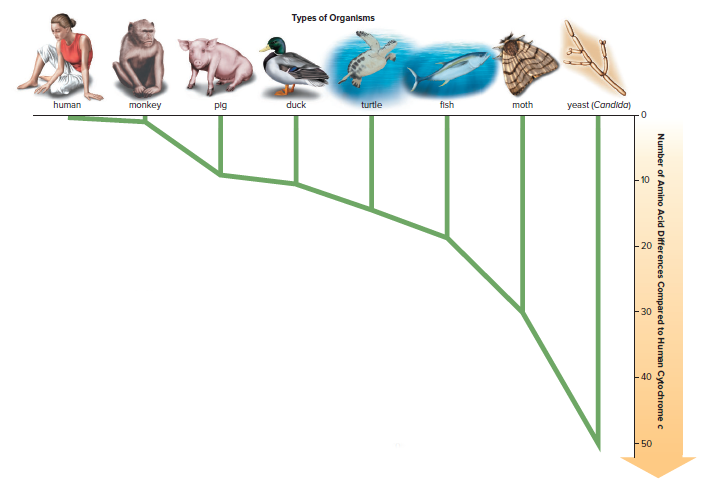
Chapter 14: Darwin and Evolution
14.1 Darwin’s Theory of Evolution
Charles Darwin was 22 years old when he became a naturalist on the HMS Beagle in 1831.
He had a background in nature and was a collector of insects.
He was interested in science and attended lectures in biology and geology.
Darwin did geology fieldwork at Cambridge before being recommended to the captain of the Beagle as the ship's naturalist.
The voyage was supposed to take 2 years but took 5.
Darwin collected and observed a variety of lifeforms, many of which were different from those in England.
Initially, Darwin believed in the idea that species remained unchanged since creation.
During the voyage, his observations challenged this belief and led him to propose the theory of evolution.
Evolution proposes that species arise, change, and become extinct due to natural forces.

Before Darwin
Prior to Darwin, people believed that the Earth was only a few thousand years old and that species had remained the same since creation.
Investigators studied the anatomy of organisms and classified them to show that species were created to be suitable to their environment.
Explorers and collectors traveled the world and brought back currently existing species and fossils to be classified.
Fossils are the remains of once-living species found in strata, which are layers of rock formed from sedimentary material.
The ages of the strata allow scientists to estimate when these species lived, and their characteristics indicate the environment that was found in the region during that time.
Georges Cuvier founded the science of paleontology, the study of fossils, and believed in the fixity of species.
Cuvier hypothesized that a local catastrophe had caused a mass extinction whenever a new stratum of that region showed a new mix of fossils.
Cuvier's followers, called catastrophists, suggested that worldwide catastrophes had occurred and that new sets of species had been created after each event.
Cuvier and Lamarck had different views on evolution and adaptation.
Lamarck believed that evolution occurs and adaptation to the environment is the cause of diversity.
Lamarck concluded that more complex organisms are descended from less complex organisms after studying the succession of life forms in strata.
Lamarck proposed the idea of inheritance of acquired characteristics to explain the process of adaptation to the environment.
Lamarck's example of the long neck of giraffes developing over time due to stretching their necks to reach food and passing on the trait to their offspring is famous but not the primary mechanism that drives the change in species over time.
Darwin's ideas were similar to Lamarck's in that living organisms share characteristics because they have a common ancestry.
Darwin believed that species are suited to the environment through natural selection, not by their own will.
Darwin saw natural selection as the means by which different species came about.
Darwin’s Conclusions
Darwin's conclusions:
Organisms are related through common descent
Adaptation to various environments results in diversity
Based on several types of data:
Study of geology
Study of fossils
Study of biogeography
Biogeography: Study of the distribution of life forms on Earth.
Darwin’s Study of Geology and Fossils
Darwin took Charles Lyell’s book Principles of Geology with him on the Beagle voyage.
The book gave evidence that Earth is subject to slow but continuous cycles of erosion and uplift.
Weathering causes erosion; thereafter, dirt and rock debris are washed into the rivers and transported to oceans.
When these loose sediments are deposited, strata result.
The strata often contain fossils and are uplifted over long periods of time from below sea level to form land.
Lyell proposed the theory of uniformitarianism, which stated that slow changes occurred at a uniform rate.
Modern geology substantiates a hypothesis of slow and continual geological change.
Darwin observed massive geological changes firsthand during his trip.
He saw raised beaches for great distances along the coast of Argentina.
In Chile, he witnessed the effects of an earthquake that caused the land to rise several feet and left marine shells inland, well above sea level.
Darwin found marine shells high in the cliffs of the Andes Mountains.
Darwin collected fossil specimens that differed somewhat from modern species.
Once Darwin accepted the supposition that Earth must be very old, he began to think that there would have been enough time for descent with modification to occur.


Darwin’s Study of Biogeography
Darwin compared animals in South America to those in England.
Instead of rabbits, he found Patagonian hares in South America.
The Patagonian hare is actually a rodent called Patagonian mara.
Darwin wondered if similarities were due to common ancestors or convergent evolution.
Convergent evolution is when distantly related species have similar body forms due to similar habitats and behaviors.
Darwin saw how similar species replaced one another as he sailed southward along South America's eastern coast.
Related species can be modified according to environmental differences caused by changes in latitude.
Darwin found evidence of this on the Galápagos Islands.
The Galápagos Islands have unique environments and different species from the mainland and from island to island.
Darwin wondered where the species on the islands came from and what caused the islands to have different species.

There are different types of finches on the Galápagos Islands with varying beak sizes and shapes depending on their diet and habitat.
Ground-dwelling finches have beak sizes dependent on the sizes of the seeds they eat.
Tree-dwelling finches have beak sizes and shapes depending on the sizes of their insect prey.
A cactus-eating finch possesses a more pointed beak, enabling access to nectar within cactus flowers.
The Galápagos woodpecker-type finch has a sharp beak but lacks the long tongue of a woodpecker. It carries a twig or cactus spine in its beak to poke into crevices and seize insects.
Darwin speculated whether all the different species of finches he had seen could have descended from a mainland finch or if they had evolved independently on the islands.
Each of the Galápagos Islands has its own type of tortoise, with long-necked tortoises inhabiting dry areas and short-necked tortoises found in moist regions with abundant ground foliage.
Darwin wondered if the differences in tortoise types could be correlated with differences in vegetation on the islands and if they had evolved from an ancestral tortoise from the mainland of South America.

Natural Selection and Adaptation
Darwin proposed natural selection as the mechanism of evolutionary change after recognizing that adaptations develop over time.
Natural selection requires the following steps:
The members of a population have heritable variations.
The population produces more offspring than the resources of an environment can support.
The individuals that have favorable traits survive and reproduce to a greater extent than those that lack these traits.
Over time, the proportion of a favorable trait increases in the population, and the population becomes adapted to the environment.
The finches of the Galápagos Islands have continued to provide a wealth of information on evolutionary processes.
Drs. Peter and Rosemary Grant led a 30-year study of a species of ground finch on the island of Daphne Major in the Galápagos, documenting the evolutionary change of a species in response to changes in the environment.
Natural selection lacks any directedness or anticipation of future needs and is an ongoing process because the environment of living organisms is constantly changing.
Extinction can occur when previous adaptations are no longer suitable for a changed environment.
Organisms Vary in Their Traits
Darwin emphasized that population members have functional, physical, and behavioral variations.
Prior to Darwin, variations were considered imperfections and ignored.
Darwin realized that variations are essential to natural selection.
Darwin believed that variations occur randomly and for no particular purpose.
Genes and environment determine an organism's phenotype.
Inherited genes are based on chromosome assortment during meiosis and fertilization.
New alleles result from inheritable mutations in an organism's DNA.
Mutations are more likely to be harmful than beneficial.
Occasionally, a mutation produces a benefit, such as a change in camouflage.
This type of variation is passed on from generation to generation, allowing for adaptation to the environment.
Organisms Struggle to Exist
Thomas Malthus emphasized the reproductive potential of humans in Darwin's time.
Malthus proposed that death and famine are inevitable due to the human population increasing faster than the food supply.
Darwin applied this concept to all organisms and found that available resources were insufficient for all members of a population to survive.
Darwin calculated the reproductive potential of elephants and concluded that a single pair of elephants' descendants would number about 19 million after 750 years.
No environment can support an elephant population of this magnitude.
Each generation has the same reproductive potential, leading to a constant struggle for existence.
Only certain members of a population survive and reproduce each generation.
Organisms Differ in Fitness
Darwin emphasized that variations are essential to the natural selection process.
Prior to Darwin, variations were considered imperfections that should be ignored.
Darwin realized that variations are functional, physical, and behavioral characteristics.
Darwin suspected that the occurrence of variations was completely random.
Genes, together with the environment, determine the phenotype of an organism.
New alleles of a gene are the result of inheritable mutations in the DNA of the organism.
Mutations are more likely to be harmful than beneficial to an organism.
Occasionally, a mutation occurs that produces a benefit to the organism.
Fitness is the reproductive success of an individual relative to other members of the population.
Fitness is determined by comparing the number of surviving fertile offspring that are produced by each member of the population.
The fittest individuals are the ones that capture a disproportionate amount of resources and convert these resources into a larger number of viable offspring.
What determines fitness varies for different populations.
Background matching helps an animal both capture prey and avoid being captured.
Darwin noted that when humans carry out artificial selection, they breed selected animals that have particular traits they want to reproduce.
In nature, interactions with the environment determine which members of a population reproduce to a greater degree than other members.
The result of natural selection is not predesired.
Natural selection occurs because certain members of a population happen to have a variation that allows them to survive and reproduce to a greater extent than other members.

Organisms Become Adapted
Adaptations may take many generations to evolve.
Unrelated organisms living in a particular environment may display similar characteristics as an adaptation.
Manatees, penguins, and sea turtles all have flippers as an example of convergent evolution.
Adaptations help organisms escape their predators and are suited to their way of life.
Natural selection causes adaptive traits to be increasingly represented in each succeeding generation.
Natural selection is the process that allows a population to adapt to its environment.
Other processes are also at work in the evolution of populations.

Darwin and Wallace
Darwin waited over 20 years to publish his book On the Origin of Species after the HMS Beagle returned to England in 1836.
During this time, he used the scientific process to support his hypothesis that today's diverse life forms arose by descent from a common ancestor and that natural selection is a mechanism by which species can change and new species can arise.
Darwin was prompted to publish his book after reading a similar hypothesis formulated by Alfred Russel Wallace.
Wallace was an English naturalist who went on collecting trips to the Amazon and the Malay Archipelago, where he divided the islands into a western and eastern group based on the organisms found there.
The sharp line dividing these two island groups within the archipelago is now known as Wallace's Line.
Wallace wrote an essay called "On the Law Which Has Regulated the Introduction of New Species," where he proposed that every species has come into existence coincident both in time and space, with a preexisting closely allied species.
After reading Malthus's treatise on human population increase, Wallace conceived the idea of "survival of the fittest" and proposed natural selection as an agent for evolutionary change in an essay he sent to Darwin for comment.
Darwin was stunned and found Wallace's ideas to be so similar to his own that even Wallace's terms now stand as heads of his chapters.

Darwin suggested that Wallace's paper be published immediately.
Lyell and others suggested that a joint paper be read to the Linnean Society.
On July 1, 1858, Darwin and Wallace presented a joint paper to the Linnean Society.
Darwin's section of the paper was titled "On the Tendency of Species to Form Varieties; and on the Perpetuation of Varieties and Species by Natural Means of Selection."
Wallace's section of the paper was titled "On the Law Which Has Regulated the Introduction of New Species."
The joint paper announced to the world that species share a common descent and have diverged through natural selection.
14.2 Evidence of Evolutionary Change
The evolutionary theory includes natural selection and descent with modification.
All living organisms have a common ancestor.
Each organism has become adapted to its environment through natural selection.
A hypothesis becomes a scientific theory when supported by evidence from independent investigators.
Darwin suggested natural selection as the mechanism for species change over 150 years ago.
Countless scientific studies have supported the ideas of species changing over time, being related through common descent, and being adapted to their environment through natural selection.
Evolution is the unifying principle in biology.
Evolutionary theory helps biologists understand the complex nature of life in various fields of biology.
This section will explore evidence of evolutionary change.
Darwin was aware of much of this evidence except for biochemical data.
Fossil Evidence
Fossils in rock strata provide the fossil record that tells us about the history of life.
The fossil record shows a succession of life-forms from simple to complex, but occasionally this pattern is reversed.
Transitional fossils are particularly interesting as they serve as links between groups.
Archaeopteryx fossils show that birds have reptilian features, including jaws with teeth and long, jointed tails.
Tiktaalik roseae is a transitional form between fish and four-legged animals, the tetrapods, estimated to be 375 million years old.
Tiktaalik has a mix of fishlike and tetrapod-like features that illustrate the steps in the evolution of tetrapods from a fishlike ancestor.
A snake fossil dated to 90 MYA showed hip bones and hindlimbs, a trait absent in all living snakes and is considered a transitional link between lizards and snakes.
The fossil record also provides important insights into the evolution of whales from land-living, hoofed ancestors.



Biogeographical Evidence
Biogeography is the study of the distribution of organisms throughout the world.
Organisms evolve in one place and then spread to other accessible regions.
Different mixes of plants and animals are expected wherever geography separates continents, islands, or seas.
Darwin noted that South America lacked rabbits, even though the environment was suitable for them, concluding that rabbits evolved elsewhere and had no means of reaching South America.
Cactuses and euphorbia are plants adapted to a hot, dry environment, but they grow in different continents because they evolved similar adaptations on their respective continents.
Islands are home to many unique species of animals and plants found nowhere else, and the reasonable explanation is that an ancestral species migrated to different islands and evolved into different species due to geographic isolation.
Marsupials and placental mammals arose when South America, Antarctica, and Australia were connected, but marsupials are now plentiful only in Australia because they had no competition from placental mammals.

Anatomical Evidence
Darwin showed that the common descent hypothesis explains vestigial structures and anatomical similarities among organisms.
Vestigial structures are fully developed in one group of organisms but reduced and nonfunctional in other similar groups.
Examples of vestigial structures include reduced wings in ostriches, remnants of hip bones and legs in extinct whales and snakes, and tailbones in humans.
The common descent hypothesis explains the presence of vestigial structures as organisms inherit their anatomy from their ancestors.
Vertebrate forelimbs have different functions but contain the same sets of bones organized in similar ways.
The unity of anatomy in vertebrate forelimbs is explained by the basic forelimb plan belonging to a common ancestor.
Anatomically similar structures explainable by inheritance from a common ancestor are called homologous structures.
Analogous structures serve the same function but are not constructed similarly and could not have a common ancestry.
The wings of birds and insects are analogous structures.
All vertebrates have a postanal tail and exhibit paired pharyngeal pouches supported by cartilaginous bars during embryological development.
Pharyngeal pouches develop into functioning gills in fishes and amphibian larvae.
In humans, the first pair of pouches become the cavity of the middle ear and the auditory tube, the second pair becomes the tonsils, and the third and fourth pairs become the thymus and parathyroid glands.
New structures originate by modifying the preexisting structures of an organism's ancestors.


Molecular Evidence
All living organisms use the same basic biological molecules, including DNA, ATP, and many identical or nearly identical enzymes.
Organisms utilize the same DNA triplet code and the same 20 amino acids in their proteins.
Humans share a large number of genes with much simpler organisms.
Many developmental genes, called Hox genes, are shared in animals ranging from worms to humans.
Life’s vast diversity has come about through only slight differences in the same genes.
A similar gene in arthropods and vertebrates determines the back-to-front axis, but although the base sequences are similar, the genes have opposite effects.
When the degree of similarity in DNA base sequences of genes or in amino acid sequences of proteins is examined, the data are as expected, assuming common descent.
Data regarding differences in the amino acid sequence of cytochrome c show that the sequence in a human differs from that in a monkey by only 1 amino acid, from that in a duck by 11 amino acids, and from that in Candida, a yeast, by 51 amino acids.
These data are consistent with other data regarding the anatomical similarities of these organisms and therefore demonstrate their relatedness.

 Knowt
Knowt
